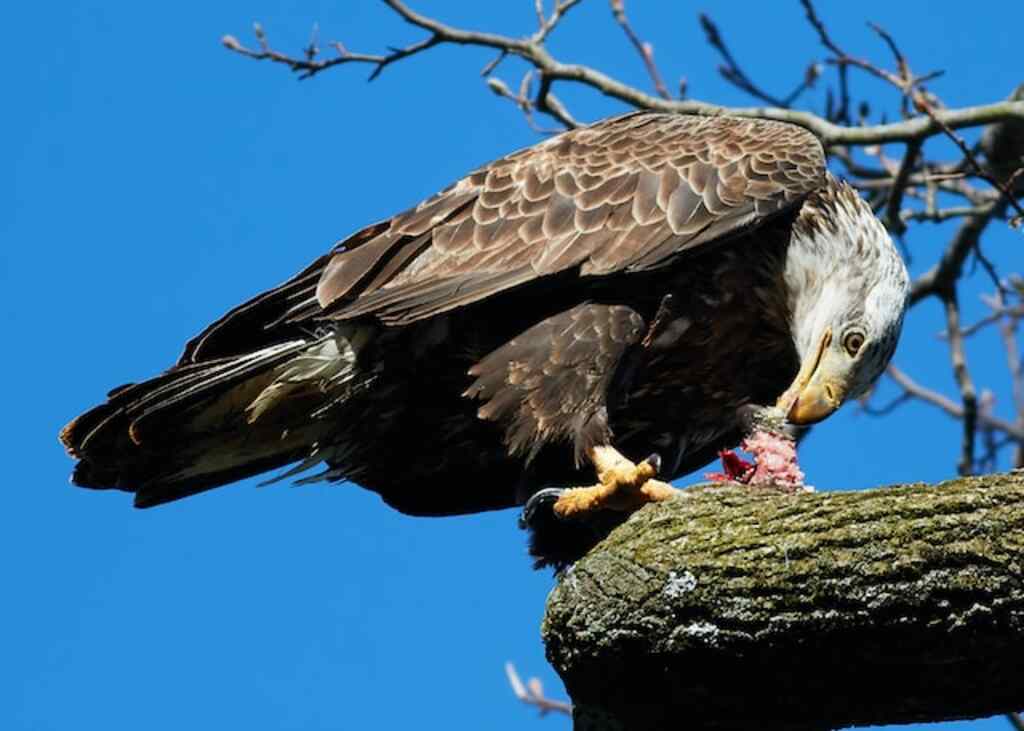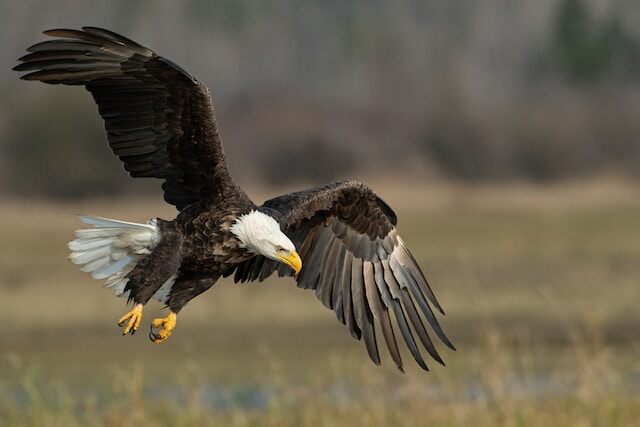With their awe-inspiring presence and predatory prowess, eagles have long captivated our imagination. But do eagles eat birds? Join us as we unravel the mysteries of eagle diets.
From their hunting skills to dietary variations among species, we’ll explore the vital role birds play in their lives and the intricate balance of nature they inhabit.
Table of Contents
- 1 Overview of Eagle’s Diet
- 2 Predatory Skills and Hunting Abilities
- 3 Variety of Prey
- 4 Do Eagles Eat Birds
- 5 Incorporation of Birds in Diet
- 6 Dietary Variations Among Eagle Species
- 7 Hunting Techniques and Adaptations
- 8 Role of Birds in Eagle’s Diet
- 9 Importance of Balance in Diet
- 10 Conservation of Eagle Populations
- 11 Frequently Asked Questions
- 11.1 How many species of eagles incorporate birds into their diet?
- 11.2 What are the hunting techniques and adaptations that eagles use to catch birds?
- 11.3 What is the role of birds in the overall diet of eagles?
- 11.4 How important is maintaining a balance in their diet for eagle populations?
- 11.5 What conservation efforts are being made to protect eagle populations and their dietary needs?
- 12 Conclusion
- 13 Author
Overview of Eagle’s Diet
The diet of eagles consists mainly of other birds, including waterfowl, small mammals, and fish.
Eagles are skilled predators that employ various predation strategies to obtain their food.
They have sharp talons and beaks that enable them to catch and kill their prey.
Eagles are known for their impressive hunting abilities, including their keen eyesight, which allows them to spot potential prey from great distances.
They are also adept at soaring and can cover large areas in search of food.
Their feeding habits involve swooping down from the sky to snatch their prey with their strong talons, and then carrying it away to a safe location to consume.
These predatory skills and hunting abilities make eagles efficient hunters in their natural habitats.
Transitioning into the subsequent section about predatory skills and hunting abilities, eagles possess an array of adaptations that enable them to excel in their role as top predators.
Predatory Skills and Hunting Abilities
With their impressive aerial prowess and razor-sharp talons, these majestic avian predators display unparalleled hunting acumen, preying on smaller avian species.
Eagles exhibit a range of hunting strategies that enable them to successfully capture their prey.
They utilize their keen eyesight to spot potential targets from great distances, allowing them to swoop down with incredible speed and accuracy.
Their talons act as lethal weapons, enabling them to firmly grasp their victims mid-flight.
Eagles often employ a technique known as stooping, where they dive steeply from the sky to surprise their prey and deliver a fatal blow.
This predatory behavior is a testament to their exceptional hunting abilities and demonstrates their mastery of the skies.
Transitioning into the subsequent section about the variety of prey, eagles’ hunting behavior and strategies contribute to their ability to capture a diverse range of avian species.
Variety of Prey
The variety of prey that eagles consume includes fish, small mammals, and reptiles.
Fish make up a significant portion of an eagle’s diet, with species such as trout, salmon, and catfish being commonly targeted.
Small mammals, such as rabbits, squirrels, and rodents, are also hunted by eagles, often utilizing their powerful talons to capture and kill their prey.
Additionally, eagles are known to prey on reptiles, including snakes and turtles, using their sharp beak to grasp and immobilize them before consuming them.
Fish
Eagles are known to have a diverse diet, including a significant portion of fish. Fish make up an essential part of an eagle’s diet due to their abundance and accessibility. They are particularly skilled at catching fish, using their sharp talons to snatch them out of the water.
One reason why fish are a preferred prey item for eagles is their migratory behavior. Many fish species migrate to reproduce or find food, creating predictable patterns that eagles can exploit.
This allows eagles to strategically position themselves along rivers, lakes, or coastlines, increasing their chances of a successful hunt.
Additionally, the consumption of fish by eagles has a significant impact on aquatic ecosystems.
As top predators, eagles help maintain the balance of fish populations by preying on weaker or sick individuals, preventing overpopulation and the spread of diseases.
Furthermore, when eagles consume fish, they may inadvertently transport fish eggs or small aquatic organisms to other water bodies, aiding in the dispersal of species and promoting genetic diversity.
Overall, the inclusion of fish in an eagle’s diet is crucial for their survival and has far-reaching effects on the ecosystems they inhabit.
Transitioning to the next section about ‘small mammals,’ it is interesting to explore the diverse range of prey that eagles target.
Small Mammals
Small mammals, such as rodents and rabbits, constitute a significant portion of the prey base for many raptor species, with studies indicating that they make up approximately 40-60% of their diet.
The diversity of small mammals is vast, ranging from mice and voles to larger species like hares and rabbits.
This wide range of prey species provides raptors, including eagles, with a versatile food source.
The impact of eagles preying on small mammals extends beyond their individual survival and plays a crucial role in maintaining ecosystem balance.
By regulating the population of small mammals, eagles help control their numbers and prevent overpopulation, which can lead to ecological imbalances.
Additionally, the predation of small mammals by eagles contributes to nutrient cycling in ecosystems.
When eagles consume small mammals, they break down their bodies, releasing nutrients back into the environment through their waste.
These nutrients then become available to plants and other organisms, supporting the overall productivity and health of the ecosystem.
Transitioning into the subsequent section about ‘reptiles’, it is essential to explore the role of eagles in maintaining ecological equilibrium by preying on different prey types.
Reptiles
Reptiles, such as snakes and lizards, inhabit a wide range of habitats, from lush forests to arid deserts, and provide a diverse prey base for raptors.
These cold-blooded creatures have evolved various adaptations that enable them to survive in these different environments.
When it comes to eagle hunting, reptiles play an important role in their diet. Eagles, being opportunistic hunters, are known to target reptiles as part of their prey.
Snakes and lizards offer a significant source of nutrition for eagles, as they are rich in proteins and provide a good energy source.
The ability of eagles to hunt reptiles is enhanced by their excellent eyesight, which allows them to spot even the smallest movement on the ground.
Additionally, eagles have sharp talons and beaks that enable them to catch and kill their prey efficiently.
While reptiles make up a portion of an eagle’s diet, it is important to note that eagles have a varied diet and also incorporate other animals such as birds and amphibians.
This diversity in prey allows eagles to adapt to different ecosystems and maintain a balanced diet.
Do Eagles Eat Birds
Yes, eagles are known to eat birds as part of their diet. With their exceptional hunting skills, eagles capture and consume a variety of prey, including birds, mammals, reptiles, and fish.
Their dietary preferences may vary among species and habitats, but birds are indeed a significant component of an eagle’s diet.
Incorporation of Birds in Diet
The incorporation of birds in the diet of eagles is influenced by various factors, including the types of birds targeted and the factors that influence prey selection.
Eagles are known to target a wide range of bird species, including waterfowl, seabirds, and songbirds.
The selection of these birds as prey is influenced by factors such as availability, habitat, and the eagles’ own foraging strategies.
Types of Birds Targeted
Various species of birds are targeted by eagles for their prey. Eagles have a diverse diet that includes a wide range of birds, especially those that are considered birds of prey.
These birds, such as hawks, falcons, and owls, are often the prime targets for eagles due to their size and vulnerability.
Additionally, eagles also target birds that are in the midst of migration, taking advantage of their weakened state during this long and arduous journey.
The diversity of bird species targeted by eagles showcases their adaptability and ability to exploit different food sources.
This allows eagles to maintain a varied diet and maximize their chances of successful hunting.
Understanding the types of birds targeted by eagles provides insight into the ecological role eagles play within the avian community.
Moving forward, it is important to explore the factors influencing prey selection by eagles to gain a comprehensive understanding of their hunting behavior.
Factors Influencing Prey Selection
Factors such as size, vulnerability, and migratory patterns influence the prey selection of eagles, shedding light on their adaptive hunting behavior.
Eagles are opportunistic predators, and their choice of prey is influenced by several factors. One important factor is the size of the prey.
Eagles tend to target smaller birds that are easier to capture and handle. Larger birds may be too difficult to subdue and carry away, making them less attractive as prey.
Vulnerability is another factor that plays a role in prey selection. Eagles are more likely to target birds that are injured, sick, or weak, as they are easier to catch and subdue.
Additionally, migratory patterns of birds also influence the prey selection of eagles. During migration seasons, large flocks of birds gather in certain areas, providing eagles with abundant prey opportunities.
These factors allow eagles to optimize their hunting efficiency and maximize their chances of successful predation.
| Factors Influencing Prey Selection | Adaptive Hunting Behavior |
|---|---|
| Size | Target smaller birds |
| Vulnerability | Prefer injured or weak birds |
| Migratory Patterns | Exploit large flocks of birds |
By understanding these factors, we can gain insights into the dietary variations among eagle species. Without explicitly stating ‘step’, it is important to explore how eagles adapt their prey selection strategies to the specific characteristics of their environment and available prey.
Dietary Variations Among Eagle Species
Dietary preferences among different species of eagles vary significantly.
While eagles are known for their bird diet, the specific types of birds they consume can differ depending on the species.
For example, the bald eagle, a well-known species in North America, primarily feeds on fish, but also scavenges on carrion and occasionally preys on small mammals.
In contrast, the golden eagle has a more diverse diet, including birds, rabbits, squirrels, and even larger prey such as deer fawns.
The white-tailed eagle, found in Europe and Asia, also consumes a variety of bird species, fish, and mammals.
These variations in dietary preferences can be attributed to factors such as habitat availability, competition, and ecological niche.
Understanding the dietary variations among eagle species provides important insights into their ecological roles and adaptations.
Transitioning into the subsequent section about hunting techniques and adaptations, these dietary variations are closely linked to the hunting strategies and specialized adaptations that eagles have developed to capture their preferred prey.
Hunting Techniques and Adaptations
Eagles are known for their diverse hunting techniques and remarkable adaptations that enable them to capture prey efficiently.
Their hunting strategies vary depending on the species and the type of prey they target.
The beak and talon adaptations of eagles play a crucial role in their hunting success.
The sharp and curved beak allows them to tear apart flesh, while their strong and powerful talons help them grasp and immobilize their prey.
Eagles employ a range of hunting techniques, including aerial hunting, perch hunting, and plunge diving.
Aerial hunting involves soaring high in the sky and scanning the ground for potential prey.
Once a suitable target is spotted, the eagle will dive down swiftly, using its exceptional speed and agility to catch the prey off guard.
Perch hunting involves patiently waiting on a high vantage point, such as a tree branch or rock, and swooping down to capture prey that comes within reach.
Plunge diving is a more specialized technique used by fish-eating eagles, where they dive into water from great heights to snatch fish near the surface.
These hunting strategies and adaptations demonstrate the remarkable adaptability and versatility of eagles as apex predators in their ecosystems.
Transitioning to the subsequent section about the role of birds in an eagle’s diet, it is important to understand how these hunting techniques and adaptations contribute to the consumption of avian prey.
Role of Birds in Eagle’s Diet
Avian prey forms a significant proportion of the eagle’s diet, with studies showing that birds make up approximately 60% of their overall prey consumption.
Eagles are skilled hunters and have adapted various hunting techniques to capture birds, including aerial pursuits, ambushes, and even stealing prey from other birds.
They have strong talons and sharp beaks that enable them to efficiently catch and kill their avian prey.
While many birds are captured by eagles as live prey, eagles also scavenge on carrion, including dead birds, which further contributes to their bird-based diet.
This predation on birds can have a notable impact on bird populations, especially in areas where eagles are abundant.
However, it is important to note that eagles play a role in maintaining the balance of bird populations by targeting weaker individuals or diseased birds, thus promoting the overall health of the avian community.
Transitioning to the subsequent section about the importance of balance in the eagle’s diet, it is crucial to understand how eagles maintain a varied diet to ensure their survival and well-being.
Importance of Balance in Diet
Maintaining a balanced diet is crucial for the overall health and well-being of eagles, as it ensures they receive the necessary nutrients from a variety of food sources.
Eagles are opportunistic predators and have the ability to feed on a wide range of prey items.
While birds make up a significant portion of their diet, it is important for eagles to have a balanced intake of other food sources as well.
A balanced diet provides eagles with the essential nutrients, such as proteins, fats, vitamins, and minerals, that are necessary for their growth, reproduction, and overall functioning.
It also helps in maintaining their immune system and preventing diseases.
By consuming a diverse range of prey, including birds, fish, small mammals, and carrion, eagles can obtain a wide array of nutrients and avoid potential deficiencies.
This balance in nutrition is essential for their survival and successful reproduction.
Moving forward to the subsequent section about the conservation of eagle populations, it is vital to understand the importance of maintaining a balanced diet for the long-term sustainability of these majestic birds.
Conservation of Eagle Populations
Preserving the populations of these majestic raptors requires a comprehensive and collaborative conservation approach.
The decline in eagle populations is a cause for concern, and human impact plays a significant role in this decline.
Factors such as habitat loss, pollution, and disturbance have contributed to the decrease in eagle numbers.
To address these issues, conservation efforts must focus on protecting and restoring suitable habitats for eagles, reducing pollution that affects their food sources, and minimizing disturbances in their nesting and foraging areas.
Additionally, public awareness and education programs can play a crucial role in promoting understanding and appreciation for these magnificent birds, fostering a sense of responsibility towards their conservation.
By implementing these measures, we can work towards safeguarding eagle populations and ensuring their continued existence for future generations.
| Human Impact on Eagle Populations | Conservation Measures |
|---|---|
| Habitat Loss | Protect and restore suitable habitats for eagles. |
| Pollution | Reduce pollution that affects eagle’s food sources. |
| Disturbance | Minimize disturbances in nesting and foraging areas. |
Frequently Asked Questions
How many species of eagles incorporate birds into their diet?
Several species of eagles incorporate birds into their diet. These majestic birds of prey have evolved to be skilled hunters, targeting a variety of avian species as a source of sustenance.
What are the hunting techniques and adaptations that eagles use to catch birds?
What hunting techniques and adaptations do eagles employ to capture birds? How do they utilize their keen eyesight, powerful talons, and aerial agility to secure their prey? These questions will be explored in this scientific examination.
What is the role of birds in the overall diet of eagles?
The role of birds in the overall diet of eagles is significant, as they are a primary source of sustenance for these raptors. Bird consumption has a direct impact on eagle populations, shaping their ecological dynamics and survival strategies.
How important is maintaining a balance in their diet for eagle populations?
Maintaining a balanced diet is crucial for eagle populations as it ensures they receive adequate nutritional requirements. For example, a study found that when eagles lacked diversity in their diet, they experienced negative impacts on their reproductive success and overall population health.
What conservation efforts are being made to protect eagle populations and their dietary needs?
Conservation efforts to protect eagle populations and their dietary needs include habitat preservation, restoration of nesting sites, and monitoring of prey populations. These measures ensure the availability of suitable habitats and prey for eagles to maintain a balanced diet.
Conclusion
In conclusion, the diet of eagles is a fascinating subject that showcases their predatory skills and hunting abilities.
These majestic birds have a diverse range of prey, with birds being an important component of their diet.
However, it is important to note that the specific dietary preferences can vary among different eagle species.
Eagles employ various hunting techniques and adaptations to capture their prey, displaying their remarkable ability to soar through the skies and seize their target with precision.
Birds play a significant role in the eagle’s diet, providing them with essential nutrients and energy. The balance in their diet is crucial for the overall health and survival of these magnificent creatures.
As we delve into the world of eagles, we can appreciate the intricate web of life and the delicate balance that exists within ecosystems.
Eagles, with their keen hunting skills and dietary adaptations, are not only awe-inspiring but also play a vital role in maintaining the ecological equilibrium.
Studying and conserving eagle populations is essential for the preservation of these remarkable birds and the biodiversity they contribute to.
Let us marvel at the grace and power of eagles, as they soar through the skies, embodying the true spirit of nature’s hunters.







